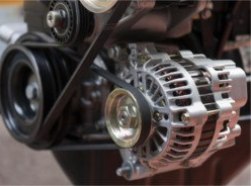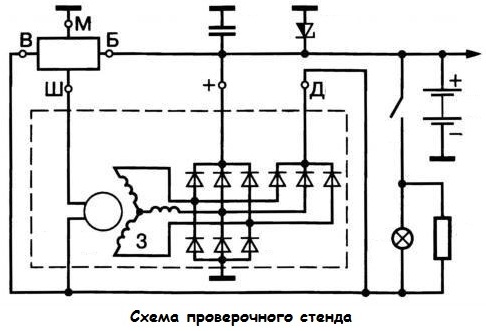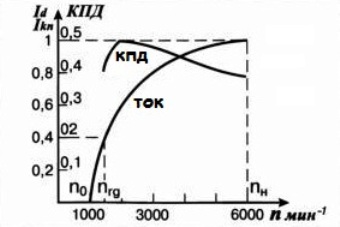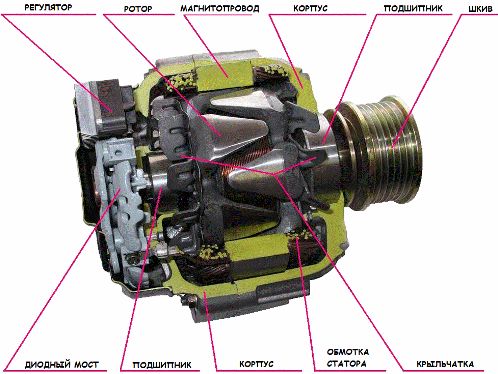Categories: How does it work, Auto electrician
Number of views: 30681
Comments on the article: 0
Car generator and its features
 In the framework of this article, we will talk about the features of the principle device of automobile generators. For car owners who are versed in the subject, this article will not be interesting. But for those who are interested in automotive generators in terms of application, this information may be useful.
In the framework of this article, we will talk about the features of the principle device of automobile generators. For car owners who are versed in the subject, this article will not be interesting. But for those who are interested in automotive generators in terms of application, this information may be useful.
In modern cars, synchronous three-phase AC electric machines are used as generators, in which the Larionov circuit is used in the rectifier.
In order for the generator to give current to the load after starting the engine, it is necessary to provide power to the field coil. This occurs when the ignition key is turned to the operating position.
The current in the field winding is controlled by a voltage regulator, which can be made as a separate unit or integrated into the brush unit of the generator. In the vast majority of modern generators, the voltage stabilizer (CH) is powered by a separate rectifier section.
Among other alternators, the automobile generator stands out for several features. First of all, the car generator, although it produces direct current, is in fact an alternating current generator, which is then rectified by a diode bridge and converted into direct current.
This solution is very popular, the same alternator from an induction motor can be turned into a direct current generator, just add a diode rectifier.
Alternating current rectifiers are called DC valve generators. These generators include a car generator.
The output voltage of the car alternator is constant
One of the distinguishing features of a car generator is the voltage at its output terminals is maintained in a narrow range using a special stabilizer called a voltage regulator. But this is not something exceptional for electric cars.
Voltage stabilizers can be found in the configuration of many uninterruptible power supplies, including among those that take energy for their batteries from mechanical generators of the same home HPPs or from solar panels.
The main distinguishing feature of the automobile generator is that it receives mechanical energy through the belt from the crankshaft of the internal combustion engine, whose rotational speed is not at all constant, it depends on the operating mode of the vehicle at the moment, and is not related to the needs of DC consumers .
So it turns out that the task of the generator and its electronics is to be able to charge the car battery and supply consumers with stabilized voltage, regardless of what the current speed of the armature is - the voltage must remain in a narrow corridor in the region of 14 volts.

If for some reason the voltage goes beyond the stabilization range, the charging current of the battery can become extremely high, and the electrolyte will simply boil away.
This phenomenon is not something unprecedented, many car enthusiasts came across it when the voltage regulator on the generator suddenly failed - the electrolyte in the battery in this case quickly boils out.
If the voltage from the generator is too low, then the battery will prematurely discharge. This problem was also faced by many motorists.
So, a stable output voltage is a prerequisite for the correct operation of a car generator. But this is not so easy to achieve. The range of variation of the rotor speed of the generator in the car is quite wide.At idle, this is about 800 - 1200 revolutions per minute, and at the moment of good acceleration - up to 5000 and even up to 6000 revolutions per minute, depending on what kind of car it is.
Current-speed characteristic of a car generator
Thus, since the voltage of the automobile generator is maintained almost constant thanks to the voltage regulator, it has its own current-speed characteristic (TLC), because at different rotor speeds, the load current is different. The voltage is constant, but the higher the speed - the higher the current, and the lower the speed - the less current from the power terminals of the generator.
It is noteworthy by the way that the car generator has a current limit, and therefore has the property of self-limitation. This means that when the current reaches a certain limit value, no matter how the speed rises further, the current will no longer increase, it simply will not be able to.

Tokoskostanaya characteristic (TLC) of the automobile generator is removed according to the methodology adopted as an international standard. It (characteristic) is removed during the test operation of the generator on a stand paired with a fully charged battery of such a nominal capacity, which in ampere-hours is half (50%) of the nominal generator current in amperes. Characteristic important points are found on the characteristic: n0, nrg, nн, nmax.
The initial rotor speed n0 is the theoretical rotor speed without load. Since the characteristic begins to be taken starting from a current of 2 amperes, this point is found by extrapolating the characteristic to the intersection with the horizontal axis of revolutions.
The minimum operating frequency of the generator nrg is taken corresponding to the idle speed of the crankshaft. This is approximately 1,500 to 1,800 rpm for the generator rotor. The current at a given frequency, as a rule, is from 40 to 50% of the nominal value for a given generator. This current should be enough to power the minimum number of vital consumers in the car.
The nominal revolutions of the generator rotor nн is exactly the frequency at which the rated current In is generated, it must not be less than the nominal value on the passport.
The maximum rotor speed of the generator nmax is the rotor speed at which the maximum current is given by the generator, the value of which does not differ much from the nominal value of the tested generator.
For generators of domestic production, it was previously customary to indicate the rated current at 5000 rpm. The rated frequency nр for the rated current of the generator Ip, equal to two-thirds of the rated current, was also indicated. This design mode corresponded to such a mode of operation of the generator when its components were not very heated. All characteristics were taken at a voltage of 14 or 13 volts.
Self-excitation of a car generator and efficiency
A car generator is obliged to self-excite at a frequency of rotation of its rotor below the frequency when the crankshaft is idling. The test is carried out at the stand, where self-excitation should occur when the generator is connected to the battery with a warning lamp.
The capabilities of a car generator from an energy point of view are characterized by the value of its efficiency. The greater the efficiency, the less power is taken from the internal combustion engine to obtain the same useful output in the form of electric power.
The generator efficiency depends mainly on the design features of a particular product: what is the thickness of the plates in the stator and the thickness of the set, how well the plates are isolated from each other (how small are the Foucault currents), what is the resistance of the stator and rotor windings, how wide are the rotor contact rings, what is the quality of the brushes and bearings? Etc.
But one thing is for sure - the higher the rated power of the generator, the higher the efficiency.Meanwhile, the typical efficiency of automobile generators, and indeed valve generators, does not exceed 60%.
The main indicator of the generator’s capabilities is its current-speed characteristic, it clearly shows what you can expect from a particular generator, what you can count on. For characteristic points make a table for the generator.
For example, we give a table of characteristics of domestic-made generators:
Characteristics of car alternators
The range of output voltage at different speeds and depending on temperature and load reflects the capabilities of the voltage regulator of an automobile generator.
See also with us:
The main types of generators and the principles of their work
See also at i.electricianexp.com
:

